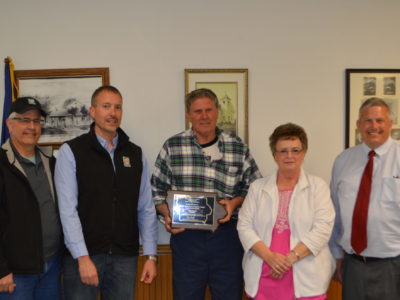Latest News

Soil Prep Tips
Excerpt from “A Guide for Installing Vegetative Environmental Buffers” A successful project not only depends on having a good plan but also doing what is necessary to properly install the plants and care for them to ensure good establishment. Many times construction of the building will create undesirable conditions for healthy plant growth. Perhaps the...
Read More
Guest Column: Siting Considerations
By: Stephanie Carlson, Iowa Pork Producers Association While Iowans strongly support farmers and give them high marks for trustworthiness and importance, they do have questions related to specific farming practices. These may include such topics as odor, water quality, property values, use of roads and bridges and proximity of other farms. These factors make proper...
Read More
Celebrating Earth Day as Stewards of the Land
By: Haley Banwart, CSIF Communications Intern “We do not inherit the land from our forefathers; we borrow it from our children.” This Native American proverb rings true as we celebrate Earth Day to inspire awareness and appreciation for the environment. As stewards of the land, today’s farmers are dedicated to improving their operations in order...
Read More
Davis Family of Wayne County Receives Wergin Good Farm Neighbor Award
The Davis family of Wayne County was recognized last week as recipients of the Gary Wergin Good Farm Neighbor Award during a ceremony at the Promise City Community Center in Promise City. Iowa Secretary of Agriculture Bill Northey presented the Davis’ with the award at an open house with family, friends and neighbors. “The Davis...
Read More
Davis Family to Receive April Wergin Good Farm Neighbor Award
West Des Moines, Iowa – April 14, 2015 – The Coalition to Support Iowa’s Farmers (CSIF) commends the Davis family of Wayne County for their outstanding efforts as a neighbors and community leaders. They have been named the April recipients of the Wergin Good Farm Neighbor award. Iowa Secretary of Agriculture Bill Northey will present...
Read More
CSIF Tips of the Month – April 2015
Blue and Gold Pride FFA, Agriculture Important to Iowa Agriculture is a big deal in Iowa, employing 21% of the state’s workforce and contributing 33% of the state’s total economic output. As employment in the ag industry continues to grow, it’s important to have young people who are excited and passionate about agriculture, but also...
Read More
Farmers Build Neighbor Support for Hog Barn Expansion
Reprinted with permission of the Iowa Farm Bureau Spokesman By Bethany Baratta Eric and Emily Crosman have always placed special emphasis on caring for their livestock and the environment. So when it came time for the Crosmans to face the Boone County Board of Supervisors during a public hearing, neighbors and friends were ready to...
Read More
‘Farming for the Future’ Expert Videos Available for Download
WEST DES MOINES, Iowa – February 23, 2015 – Livestock farmers who missed the Coalition to Support Iowa’s Farmers’ (CSIF) successful Farming for the Future conference in January can now view the various segments via video at www.supportfarmers.com/video. Each segment includes experts who can help Iowa’s livestock and poultry farmers manage changes to their farms....
Read More
CSIF Tips of the Month – February 2015
Rules and Regulations Highlight DNR Records: Make Sure Your Farm’s Information Is Correct DNR continues to inspect livestock and poultry farms across the state, per the requirements of the workplan. The initial part of the inspection process requires DNR to review their records and aerial maps for the farm to determine if an on-site inspection...
Read More
Check Permits, Records Before Livestock Inspections
Reprinted with permission of the Iowa Farm Bureau Spokesman By: Bethany Baratta As the Iowa Department of Natural Resources (DNR) continues its inspections of livestock farms as part of the work plan agreement signed with the Environmental Protection Agency (EPA) Region 7, farmers should remain prepared for a potential site visit, a leading Iowa livestock...
Read More